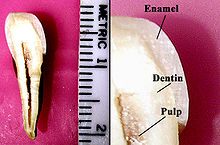Tooth pulp

1 = enamel
2 = dentin
3 = pulp cavity with pulp
4 = gingiva
5 = root cement
6 = alveolar bone
7 = alveolar artery
8 = alveolar vein
Alveolar nerve (not shown)
A = tooth crown ; B = tooth root


The tooth pulp (from Latin pulpa 'meat'), also called pulp dentis , tooth pulp or tooth nerve , fills the inner part of the tooth , the pulp cavity , which is enveloped by the hard tooth substance . The pulp cavity extends from the tooth crown to the tip of the tooth root (s).
construction
The pulp consists of connective tissue with blood and lymph vessels and nerve fibers . So-called. Tomes fibers , extensions of the odontoblasts , i.e. dentin-forming cells, continue in very fine dentinal tubules (tubules) that are invisible to the naked eye up to the enamel- dentin border. In addition to the odontoblast processes, nerve fibers are also found in some dentinal tubules. These reproduce supra-threshold mechanical , thermal or chemical stimuli as pain sensations . Various authors identified various neuropeptides (including substance P , opioid peptides ) in the pulp (and dentine) using immunohistochemical techniques and discussed a role for these in nociception of the pulp (and dentine).
Anatomically, a distinction is made between crown and root pulp.
Physiological development
Before deciduous or permanent teeth break through into the oral cavity, the cells of the pulp form dentin and enamel during tooth development . In adolescence, the pulp cavity is very wide and therefore the distance between the pulp and the tooth surface is not very large. As a result, caries can penetrate the pulp very quickly and lead to pulpitis . The pulp cavity becomes smaller with increasing age, as dentin is continuously produced from within. This in turn increases the distance between the pulp and the tooth surface continuously.
Pathological changes in the pulp
It is the task of the dentist to distinguish between reversible and irreversible pulpitis, to determine the cause and to initiate the appropriate therapy. Due to the lack of its own lymphatic drainage system, the pulp has only a very limited potential for regeneration .
One differentiates:
- Pulpitis : inflammation of the tooth pulp.
- Pulp gangrene : the pulp tissue dies by anaerobic bacteria , and dissolves.
- Denticle : Calcifications of the pulp tissue by means of rounded to oval hard tissue bodies. Causes can be old age or trauma; Denticles can also arise as a result of healing processes or therapeutic interventions. They are mostly as incidental findings on radiographs or during a root canal treatment discovered
- Apical periodontitis : inflammatory processes in the area of the tip of a tooth
- Odontogenic infections : abscesses with and without connections to the oral cavity or in the jawbone (fistula)
The treatment of choice is usually a root canal treatment , possibly including prior apexification .
Tissue engineering
New findings show that regeneration of the dental pulp in the sense of tissue engineering could be possible. Results from the field of basic research show that dental stem cells can form pulp tissue and tubular dentin after sowing in a suitable carrier material. Clinical case reports describe a procedure in young teeth with incomplete root growth, which after provocation of a hemorrhage into the root canal can lead to the regeneration of the dental pulp as the root growth progresses.
See also
Individual evidence
- ^ Joseph Maria Stowasser : Der Kleine Stowasser , Latin-German school dictionary , G. Freytag Verlag, Munich
- ↑ A. Abd-Elmeguid, DC Yu: Dental pulp neurophysiology: part 2. Current diagnostic tests to assess pulp vitality. In: Journal (Canadian Dental Association). Volume 75, Number 2, March 2009, pp. 139-143, ISSN 1488-2159 . PMID 19267966 . (Review).
- ↑ Wolfgang Hans-Michael Raab: Diagnostic Aspects of Tooth Pain , Zahnärztliche Mitteilungen 10/2000, p. 58 f.
- ↑ Göres, M., P. Oehme and R. Zuhrt: On the importance of endogenous peptides for pulpal pain. In: Zahn- Mund- Kieferheilkunde 77, pp. 531-536 (1989).
- ↑ A. Abd-Elmeguid, DC Yu: Dental pulp neurophysiology: part 1. Clinical and diagnostic implications. In: Journal (Canadian Dental Association). Volume 75, Number 1, February 2009, pp. 55-59, ISSN 1488-2159 . PMID 19239745 .
- ↑ K. Galler, Regeneration of the dental pulp in ZM 09/2013
